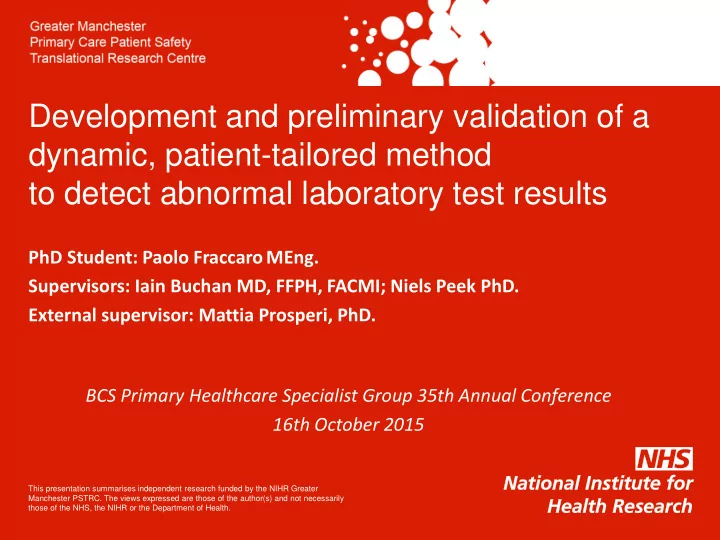

Development and preliminary validation of a dynamic, patient-tailored method to detect abnormal laboratory test results PhD Student: Paolo FraccaroMEng. Supervisors: Iain Buchan MD, FFPH, FACMI; Niels Peek PhD. External supervisor: Mattia Prosperi, PhD. BCS Primary Healthcare Specialist Group 35th Annual Conference 16th October 2015 This presentation summarises independent research funded by the NIHR Greater Manchester PSTRC. The views expressed are those of the author(s) and not necessarily those of the NHS, the NIHR or the Department of Health.
Background • Most clinical decisions involve lab results. • Failure to follow up laboratory test results is a major concern in primary care. • Electronic Health Records (EHRs) can support General Practitioners (GPs). • GPs spend ~1 hour per day processing alerts. Alert fatigue and patient safety issues Greater Manchester Primary Care Patient Safety Translational Research Centre
Example Observation value [mmol/l] Greater Manchester Primary Care Patient Safety Translational Research Centre
Population-based reference intervals Series of potassium observations for one patient Observation value [mmol/l] Greater Manchester Primary Care Patient Safety Translational Research Centre
Methods: Mixed-effects model µ and ω 2 are population mean and variance; • • y ij is the jth observation of patient i; • α i is the mean of patient I; σ 2 is the intra-patient variance; • • 𝑧 ij and n ij are the sample mean and number of observations for patient i after j observations; • µ ij and V ij are the maximum likelihood estimates of α i and σ 2 ; • λ ij is a shrinkage factor. Greater Manchester Primary Care Patient Safety Translational Research Centre
Mixed-effects model: Example on patient data Series of potassium observations for one patient Observation value [mmol/l] Greater Manchester Primary Care Patient Safety Translational Research Centre
Methods: data source and study design • Salford Integrated Record database (population ~234k, UK). • Registered patients aged 18-85 between 1990-2012. • Potassium measurements. • Training dataset ~150k patients. • Test dataset 500 patients. • Clinical relevance of alerts assessed by a survey administered to GPs (gold standard). Greater Manchester Primary Care Patient Safety Translational Research Centre
Survey Greater Manchester Primary Care Patient Safety Translational Research Centre
Survey: respondents characteristics • Survey administered to 43 GPs in Manchester (UK) • Response rate 44% (19 out of 43) • Each value was assessed by a median of 3 GPs Respondent characteristic Reply N (%) 1-3 days 10 (52.6%) Days per week in practice 4-5 days 9 (47.4%) <10 years 2 (10.5%) Years of experience 10-20 years 5 (26.3%) >20 years 12 (63.2%) Not enough 4 (21.1%) Opinion about tests alerts in general practice About right 7 (36.8%) Too much 8 (42.1%) Greater Manchester Primary Care Patient Safety Translational Research Centre
Results: Alerts prevalence, PPV and sensitivity Standard Patient-tailored Combined Parameter method method method Prevalence (N) in test dataset 11.3% (470) 9% (372) 7.3% (301) (n=4,144) Prevalence (N) in values assessed by GPs 50% (76) 50% (76) 25% (38) (n=152) Sensitivity 0.51 0.41 0.38 PPV 0.66 0.67 0.76 Greater Manchester Primary Care Patient Safety Translational Research Centre
Results: Mixed-effects logistic regression Adjusted OR Parameter [95% CI] Standard method pos. vs neg. 24.5* [5.3,113.7] Patient tailored method pos. vs. neg. 6.2* [2.0,19.1] Weekly working days in GP: 4-5 days vs 1-3 days 2.2 [0.4,11.3] Years of experience in GP: 10-20 years vs <10 years 3.5 [0.4,11.3] Years of experience in GP: >20 years vs <10 years 6.0 [0.3,103.1] Opinion about tests alerts in GP: not enough vs about right 0.5 [0.7,3.7] Opinion about tests alerts in GP: too much vs about right 0.2 [0,1.3] Estimated variance of the random effects: • assessor: 1.5 (SD:1.2) • value: 0.4 (SD: 0.6) *statistically significant Greater Manchester Primary Care Patient Safety Translational Research Centre
Conclusions Conclusions: • personalising alerts for lab results could provide useful information to clinicians; • by combining both methods together systems could be used to prioritise alerts. Future work: • introduce time-dependency; • extending evaluation to other lab tests (i.e. eGFR, calcium, creatinine); • further alert personalisation with info in EHR (i.e. age, gender, comorbidities ecc). Greater Manchester Primary Care Patient Safety Translational Research Centre
Presented project in collaboration with Thanks for your attention A partnership between The NIHR Greater Manchester Primary Care Patient Safety Translational Research Centre is funded by the National Institute for Health Research (NIHR) and is a partnership between the University of Manchester and Salford Royal NHS Foundation Trust
Recommend
More recommend